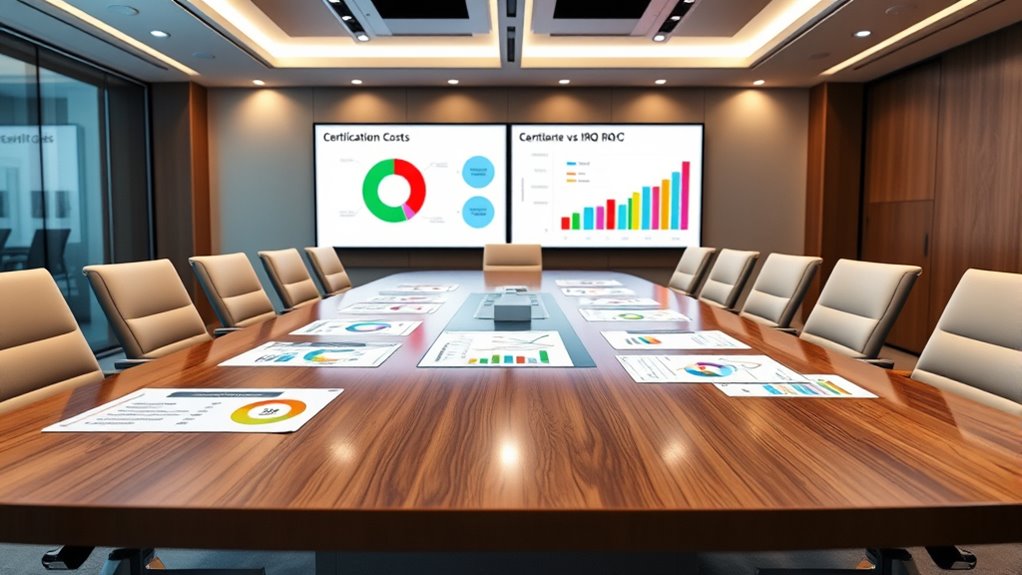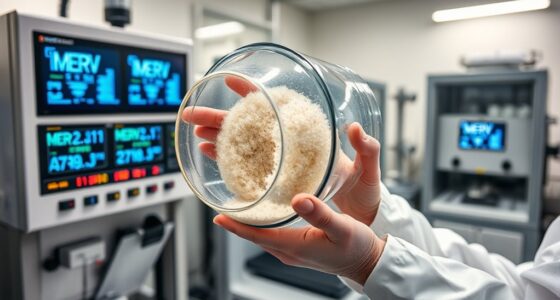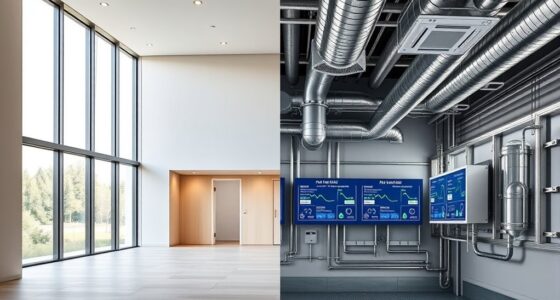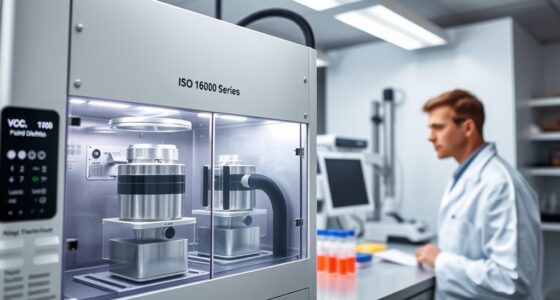Achieving IAQ certification requires an upfront investment for assessments, upgrades, and ongoing compliance. While costs can be significant, the long-term benefits often justify the expense, including higher property value, better health outcomes, and potential incentives. These improvements can lead to increased occupancy and reduced liability. The initial costs are balanced by future savings and competitive advantages—continue to explore how careful planning and investment can maximize your return on IAQ standards.
Key Takeaways
- Initial costs include assessments, testing, and necessary upgrades, with budgeting essential for a smooth certification process.
- Certification can enhance property value, attract health-conscious tenants, and increase occupancy rates, offering long-term financial benefits.
- Implementing IAQ improvements may qualify for regional incentives or rebates, offsetting some upfront expenses.
- Ongoing costs involve periodic testing, maintenance, and documentation to ensure continued compliance and certification validity.
- The long-term health, safety, and reputation benefits typically outweigh initial investments, providing a strong return on investment.
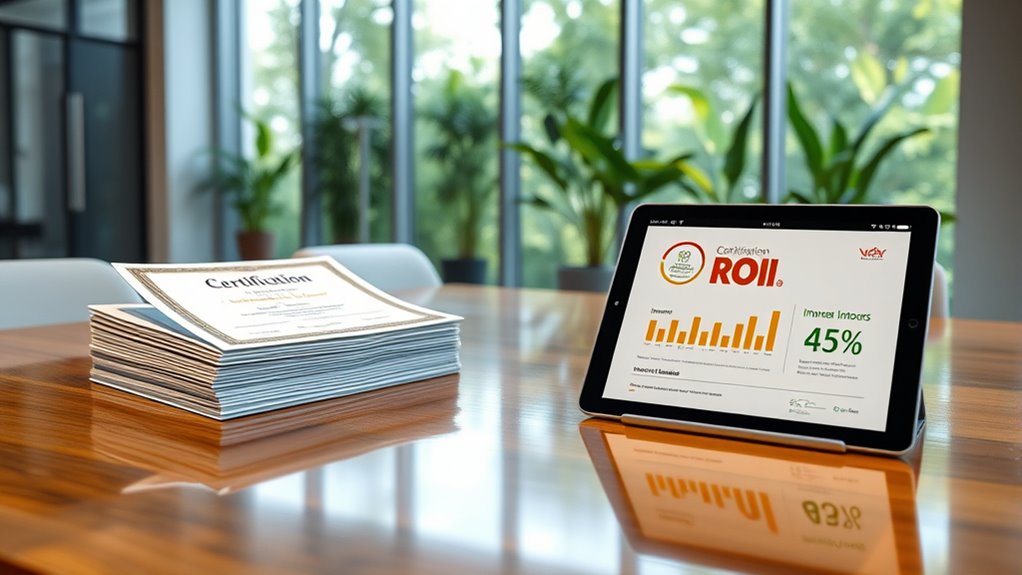
Achieving certification for Indoor Air Quality (IAQ) standards requires an upfront investment, but understanding the potential return on that investment can make the decision clearer. When considering the costs involved, it’s essential to conduct a thorough cost benefit analysis. This process helps you evaluate whether the long-term gains—such as improved occupant health, increased property value, and enhanced reputation—outweigh the initial expenses. The certification process itself can seem complex at first glance, often involving multiple steps like initial assessments, testing, documentation, and ongoing compliance checks. Knowing what each phase entails allows you to plan your budget effectively and avoid surprises down the line.
Investing in IAQ certification requires planning, but long-term health and value benefits outweigh initial costs.
The certification process typically begins with a detailed evaluation of your current IAQ conditions. This step might require hiring specialized inspectors or consultants to identify pollutants, ventilation issues, or other factors affecting indoor air quality. These assessments can be costly, but they provide a baseline that guides your improvement strategies. Once the assessment is complete, you’ll need to implement recommended upgrades or adjustments, which could include installing air filtration systems, upgrading HVAC components, or improving building materials. While these upgrades involve initial expenditure, they set the stage for achieving certification and reaping the associated benefits.
Throughout the certification process, documentation is critical. You’ll need to keep detailed records of testing results, maintenance activities, and corrective actions. This documentation not only ensures compliance but also demonstrates your commitment to high IAQ standards, which can be invaluable when marketing your property. Additionally, certification often involves periodic re-evaluations, so budgeting for ongoing testing and maintenance is part of the long-term investment. Incorporating whole-house water filtration systems as part of your overall building upgrades can further enhance indoor air quality by reducing indoor pollutants linked to water quality concerns.
From a financial perspective, it’s worth considering the potential return on investment. Achieving IAQ certification can attract tenants or buyers who prioritize health and safety, potentially leading to higher occupancy rates and rental income. It can also reduce liability and health-related costs by creating a safer environment. Furthermore, some regions offer incentives or rebates for building upgrades that improve air quality, offsetting initial costs. These benefits, combined with enhanced reputation and compliance with future regulations, create a compelling case for pursuing IAQ certification despite the initial expenditure.
Ultimately, by carefully analyzing the certification process and conducting a detailed cost benefit analysis, you’ll be better equipped to make informed decisions. While it requires an upfront commitment, the long-term advantages—both financial and intangible—often justify the investment. You’ll find that the effort invested today can lead to healthier indoor environments and a more competitive, compliant property tomorrow.
Frequently Asked Questions
How Do Certification Costs Vary Across Different IAQ Standards?
You’ll find that certification costs vary widely because of cost variability and standard differences. Some IAQ standards require extensive testing, documentation, and ongoing monitoring, which can increase expenses. Others might have more straightforward requirements, making certification more affordable. It’s essential to compare the specific standards you’re considering, as each has unique requirements that influence overall costs. By understanding these differences, you can better plan your investment in IAQ certification.
What Are Common Hidden Expenses in IAQ Certification Processes?
You might overlook hidden fees like additional documentation requirements or extra inspections that aren’t included upfront. These hidden expenses can add up quickly, especially if you need specialized reports or ongoing testing. Always review the certification process carefully to identify potential hidden fees, and verify you budget for any extra documentation or compliance measures. Being proactive helps prevent surprises and keeps your project on track financially.
How Long Does It Typically Take to See ROI From IAQ Certifications?
You typically see a return on investment within 6 months to 2 years after obtaining IAQ certifications. Your investment timeline depends on factors like improved building efficiency and tenant satisfaction, which can lead to cost recovery through reduced energy bills and increased occupancy. By consistently maintaining standards, you’ll maximize benefits and shorten the time needed to recoup your initial costs, making IAQ certification a smart, long-term investment.
Are There Financial Incentives or Subsidies for IAQ Certification?
You can often access government grants and tax incentives that make IAQ certification more affordable. Think of it like a coupon for your investments—these incentives help offset costs and boost your ROI. For example, some businesses have received grants covering up to 50% of certification expenses. By exploring local and federal programs, you can save money while enhancing your building’s air quality and demonstrating your commitment to health and safety.
How Does Certification Impact Property Value and Tenant Retention?
Certification boosts your property’s value and tenant satisfaction by demonstrating commitment to quality indoor air. When your building is certified, tenants feel safer and healthier, leading to higher retention rates. Plus, it enhances your market competitiveness, attracting new tenants who prioritize well-maintained, healthy environments. Overall, investing in IAQ certification creates a positive cycle of increased property value and tenant loyalty, making your property stand out in a crowded market.
Conclusion
Investing in IAQ standards might seem costly upfront, but the benefits far outweigh the expenses. Did you know that businesses with certified indoor air quality see a 20% decrease in sick days among employees? This not only boosts productivity but also enhances overall well-being. By prioritizing IAQ certification, you’re creating a healthier environment that pays for itself through improved health and performance. It’s a smart investment with lasting positive impacts.
